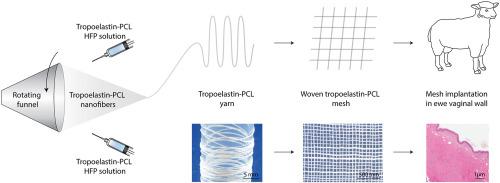Materials Today Bio ( IF 8.2 ) Pub Date : 2020-10-13 , DOI: 10.1016/j.mtbio.2020.100081 B Aghaei-Ghareh-Bolagh 1, 2 , S Mukherjee 3, 4 , K M Lockley 1, 2 , S M Mithieux 1, 2 , Z Wang 1, 2 , S Emmerson 3, 4 , S Darzi 3 , C E Gargett 3, 4 , A S Weiss 1, 2, 5

|
Pelvic organ prolapse is a common condition that affects 1 in 4 women across all age groups. It is mainly caused by vaginal birth injury and can be exacerbated by obesity and increased age. Until recently, treatment strategies often used non-degradable synthetic meshes for reconstructive surgery. However, owing to their frequent, unacceptable rate of adverse events such as mesh erosion, transvaginal meshes have been banned in many countries. Recent reports have highlighted the urgent need for biocompatible design of meshes for a safe and effective treatment in the long term.
This study reports the design and evaluation of a novel, elastin based degradable mesh using an ovine model of POP as a potential surgical treatment. Elastin is a protein component of the ECM and provides elasticity to tissues throughout the body. Tropoelastin, the monomer subunit of elastin, has been used with success in electrospun constructs as it is a naturally cell interactive polymer. Biomaterials that incorporate tropoelastin support cell attachment and proliferation, and have been proven to encourage elastogenesis and angiogenesis in vitro and in vivo.
The biological properties of tropoelastin were combined with the physical properties of PCL, a degradable synthetic polymer, with the aim of producing, characterizing and assessing the performance of continuous tropoelastin:PCL electrospun yarns. Using a modified spinneret electrospinning system and adjusting settings based on relative humidity, four blends of tropoelastin:PCL yarns were fabricated with concentration ratios of 75:25, 50:50, 25:75 and 0:100. Yarns were assessed for ease of manufacture, fibrous architecture, protein/polymer content, yarn stability - including initial tropoelastin release, mechanical strength, and ability to support cell growth. Based on overall favorable properties, a mesh woven from the 50:50 tropoelastin:PCL yarn was implanted into the vagina of a parous ewe with vaginal wall weakness as a model of pelvic organ prolapse. This mesh showed excellent integration with new collagen deposition by SEM and a predominant M2 macrophage response with few pro-inflammatory M1 macrophages after 30 days. The woven tropoelastin:PCL electrospun mesh shows potential as an alternative to non-degradable, synthetic pelvic organ prolapse mesh products.
中文翻译:

一种用于盆腔器官脱垂修复的新型弹性蛋白原可吸收手术网
盆腔器官脱垂是一种常见病,影响所有年龄组中四分之一的女性。它主要由阴道分娩损伤引起,肥胖和年龄增加可加重。直到最近,治疗策略通常使用不可降解的合成网格进行重建手术。然而,由于网片侵蚀等不良事件的频繁发生率令人无法接受,许多国家已禁止使用经阴道网片。最近的报告强调了对网格的生物相容性设计的迫切需要,以实现长期安全有效的治疗。
本研究报告了一种新型的、基于弹性蛋白的可降解网状物的设计和评估,该网状物使用 POP 的绵羊模型作为潜在的手术治疗。弹性蛋白是 ECM 的一种蛋白质成分,可为全身组织提供弹性。原弹性蛋白是弹性蛋白的单体亚基,已成功用于静电纺丝结构,因为它是一种天然的细胞相互作用聚合物。包含原弹性蛋白的生物材料支持细胞附着和增殖,并已被证明在体外和体内促进弹性生成和血管生成。
将弹性蛋白原的生物学特性与可降解合成聚合物 PCL 的物理特性相结合,旨在生产、表征和评估连续弹性蛋白原:PCL 电纺纱线的性能。使用改进的喷丝头静电纺丝系统并根据相对湿度调整设置,以 75:25、50:50、25:75 和 0:100 的浓度比制造了四种原弹性蛋白:PCL 纱线的混合物。对纱线的制造难易程度、纤维结构、蛋白质/聚合物含量、纱线稳定性进行了评估——包括初始弹性蛋白原释放、机械强度和支持细胞生长的能力。基于整体有利的特性,由 50:50 原弹性蛋白编织而成的网状物:将 PCL 纱线植入阴道壁无力的经产母羊的阴道,作为盆腔器官脱垂的模型。该网格通过 SEM 显示出与新胶原蛋白沉积的良好整合,并且在 30 天后显示出主要的 M2 巨噬细胞反应和少量促炎 M1 巨噬细胞。编织的原弹性蛋白:PCL 电纺网显示出作为不可降解的合成盆腔器官脱垂网产品的替代品的潜力。



























 京公网安备 11010802027423号
京公网安备 11010802027423号